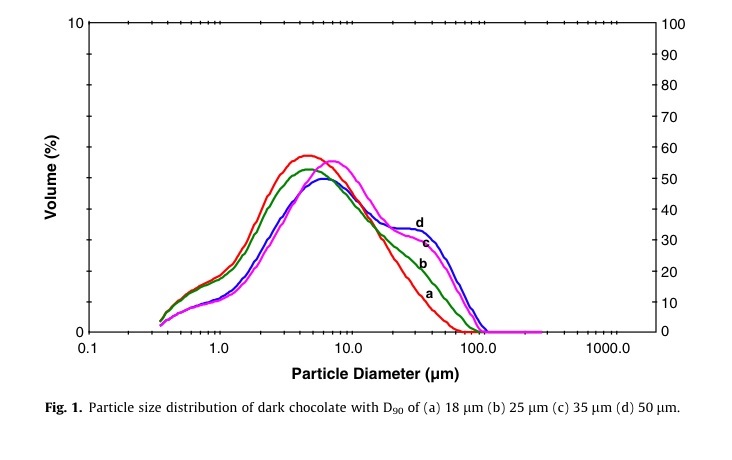I wanted to ask your advice on a spectrometer. I know that we should get our chocolate mass to a certain micron range. Would this be a good one to get or have you used a different one given the price? Also, do you recommend any other helpful tools to help with quality assurance?
http://www.amazon.com/dp/B00S941UQM/ref=wl_it_dp_o_pC_nS_ttl?_encoding=UTF8&colid=3C39Q9TYAUQ03&coliid=I5H0ZZ8Z4OP88&psc=1
My advice is don’t get hung up on numbers. At least in this and a few other cases. I like ‘numbers’ when they actively help me either repeat a process or verify a process is where I want it. But numbers for the sake of numbers is just wasting time. This isn’t quite that later case, but it also isn’t helpful.
I’m going to pick on your premise. You do not actually know your mass needs to be in a certain micron range. You know that your chocolate needs to be smooth. And smooth is a tactile sense, not a number. If you want to know if your chocolate is smooth enough just taste it. I’m dead serious about this.
There are a few reasons. But the one I just made is the main reason. You want to know if it’s smooth so use your ‘smooth’ detector. Your tongue! It is the best tool for the job.
You mention a spectrometer. First off, your link isn’t for a spectrometer. It is for something called a Grindometer. I would specifically not use it. It doesn’t really give you that much data. To paraphrase a couple sources, Grindometers are built to give a very quick indication of the high end of the particle size distribution, allowing production processes to be followed in real time. Again, your own perception will do this.
Here is the problem. The Grindometer tells you top end. But our mouth doesn’t work that way. Our perception is complicated. We take an average, with a sensitivity to the larger particle sizes to determine whether something is ‘smooth’. Basically we interpret qualitatively (i.e. without numbers) the particle size distribution in what we are tasting. Even just a few particle that are larger than the average make us say ‘coarse’. Under some average threshold we say ‘fine’. But your Grindometer is only giving a number that basically says “most everything is under 110 microns’. Not real helpful. Why? Have a look the following. It’s a particle size distribution plot of four different chocolates.
They spread the gamut of very fine to acceptably smooth. The Grindometer would tell you these all had particles in the 80-100 um range. Way coarser than the traditional bench mark of “less than 35 microns”. One reason it is not very useful. But I can hear you now. ‘I can use 80 as too fine, 85-90 as perfect and 100 as coarse’. Not really. You would be really hard pressed to see that on the Grindometer. It’s the difference in theory and practice. But for the sake of argument, let’s say you disperse your chocolate in some oil so it’s easier to see and you can see the difference. It is fully possible to have a chocolate where the largest particle is 80 um and the chocolate per your mouth is very coarse. How and why? Because of the averaging we do. Note the labels on those 4 plots above. 18 um, 25 um, 35 um, 50 um. Those are the weighted averages of the entire distribution. When you hear that chocolate should be 35 um, THIS is what they are talking about. Not less than 50 um, or less than 35 um. Not exactly 35 um. What that means is you can have a plot like the one below. There is nothing larger than 80 um, but the weighted average is 65 um so it’s going to seem coarse yet your Grindometer would have you believe it is super fine and ready to go.
Basically it’s the wrong tool for the job. The same goes for people using micrometers. I have heard it a lot, that they use them to verify they are at 50 um or 35 um or whatever….except assuming it even works (which I am skeptical about as they aren’t comparing it against a known value), it still is only giving you the largest particles which are basically unrelated to mouth feel in the critical range.
Could you use a particle size analyzer such as was used to make those plots? Sure. Maybe. The main question I would put to you is WHY? What are you going to actually do with the data that is worth $10-20,000? Especially when at the end of the day it’s the mouth feel you are concerned about and the best test for that, as I’ve said, is just to taste it and determine the mouth feel for yourself.
To close this out, I don’t want to leave you with the impression I am against fancy tools and numbers. Heck, I was a chemist for many years and love that stuff. But that experience has also shown me that trying to correlate complex numbers and graphs to the human perceptions might be sexy as all get out in a research setting, it has a tendency to fall apart in the trenches of daily production. At the end of the day your senses are amazing. Use them!
Send in your Ask the Alchemist questions to questions@chocolatealchemy.com


